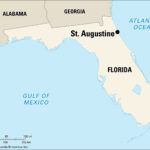Founded in 1935 by the National Park Service, the Gateway Arch National Park, previously known as the Jefferson National Expansion Memorial, serves as a powerful tribute to Thomas Jefferson’s ambition for a transcontinental United States. This significant landmark stretches from the historic Old Courthouse to the scenic overlooks of the Mississippi River, with the iconic Gateway Arch standing tall as a symbol of pioneering spirit.
The Gateway Arch is located in St. Louis, Missouri, within the Gateway Arch National Park. This park is situated on the west bank of the Mississippi River, in downtown St. Louis. More specifically, the Gateway Arch’s precise location is 100 Washington Avenue, St. Louis, MO 63102. As the centerpiece of the park, the Arch is easily accessible and serves as a central point for exploring the surrounding historical and cultural attractions.
Today, the Gateway Arch stands as a monument that celebrates the diverse individuals who have shaped both the region and the entire nation. It commemorates visionary figures such as Thomas Jefferson, who orchestrated the Louisiana Purchase in 1803, an event that doubled the size of the United States. The park also honors the intrepid explorers Lewis and Clark, along with their invaluable Shoshone guide Sacagawea, who charted the newly acquired territory and discovered a path to the Pacific Ocean.
Furthermore, the Gateway Arch acknowledges the courageous challengers like Dred and Harriet Scott, who initiated their fight for freedom from slavery at the Old Courthouse, and Virginia Minor, a St. Louis suffragette who championed women’s voting rights. The artistic vision of architect Eero Saarinen brought this monument to life, creating a lasting tribute to these pivotal figures and moments in American history.
The journey to create the monument we recognize today began in 1935 when President Franklin D. Roosevelt designated the land along the St. Louis riverfront for the Jefferson National Expansion Memorial, now known as Gateway Arch National Park. As the site was being prepared for construction, the City of St. Louis entrusted the Old Courthouse to the National Park Service, integrating it into the Memorial. A nationwide design competition in 1948 determined the Memorial’s form, and in 1963, construction commenced on Eero Saarinen’s stainless steel arch design. Completed in 1965, the Gateway Arch has become an enduring symbol of American identity and a celebrated example of mid-century modern architecture.
Serving as the western anchor of the Park, the Old Courthouse is a distinguished representation of mid-19th century federal architecture. Constructed in 1839, this Courthouse was the venue for several significant civil rights cases, most notably the Dred Scott decision. In the 1830s, Dred Scott, born into slavery, was taken to free territories in Illinois and Wisconsin before returning to Missouri. Drawing upon Missouri’s “once free, always free” principle, Scott initiated legal proceedings at the St. Louis Courthouse in 1847 and 1850 to claim his freedom. However, in 1857, the U.S. Supreme Court ruled against Scott and his wife Harriet, asserting that African-Americans were not citizens and therefore lacked the right to sue in court. The widespread dissent sparked by this decision significantly contributed to the momentum leading to the U.S. Civil War just four years later.
To delve deeper into the captivating history and engineering feats behind the Gateway Arch, explore the official National Park Service page.

